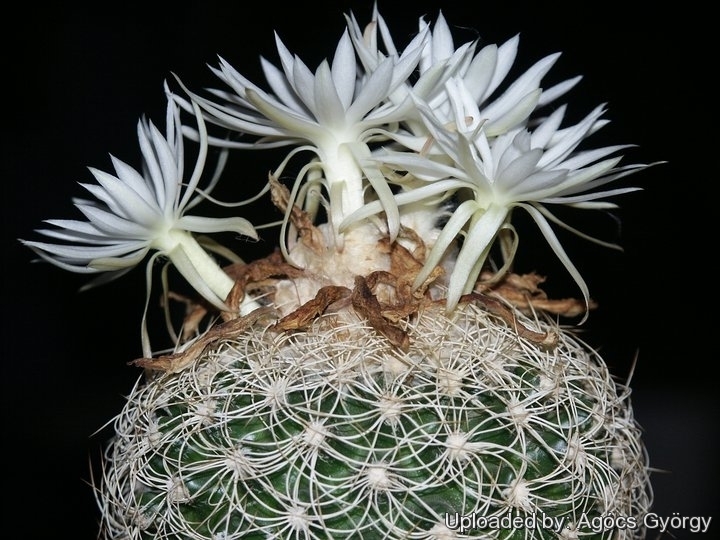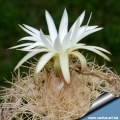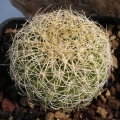Accepted Scientific Name: Discocactus zehntneri Britton & Rose
Cactaceae (Britton & Rose) 3: 218. 1922 [12 Oct 1922] Britton & Rose

Discocactus zehntneri subs. araneispinus Photo by: Agócs György
Blooming habit at Rebutialand cactus collection Demjén, Hungary.
Origin and Habitat: Southern Brazil (altitude around 1000-1200 mt )
Synonyms:
See all synonyms of Discocactus zehntneri
Description: Discocactus zehntneri subs. araneispinus, also considered just a form of Discocactus zehntneriSN|12929]]SN|12925]], is a squat tiny little solitary plant that - in culture - produces just like Discocactus boomianusSN|12925]]SN|12929]] many offsets.
Stem: Dull-green 10-20 in diameter and 7-10 cm tall. Cephalium: Up to 1 cm tall and -4 cm wide, at the apex of the plant, creamy-withe to light-brown with yellow to brownish bristles up to 2 cm..
Ribs: About 20, somewhat spiraled, forming nipple-like tubercles to 1 cm high.
Areoles: Oval, sunken, ca. 8 per ribs.
Radial spines: Interlacing, densely covering the plant, 10 to15 up to 1-2 cm long, pectinate, flexible spines creamy white or whitish-yellow with dark tips, becoming pale-brown to whitish, recurved backwards, sitting on the plant like spiders.
Central spines: None.
Flowers: White, scented, slender funnelform, up to 9 cm long. The position of the stigma is at the top of the stamens. Each flowering lasts only one night, but that night it produces many flowers.
Fruits: Club-shaped red 2,5 cm long. The plant produces seed-pods twice a year, when it flowers.
Remarks: This plant is part of the Discocactus zehentneri complex which comprises several variable subordinates taxa, but not all are universally recognized.
Subspecies, varieties, forms and cultivars of plants belonging to the Discocactus zehntneri group
 Discocactus zehntneri Britton & Rose: Usually globose and completely covered in white thin, needle-like spines, the flower is about 3 cm long and the fruit are red (Origin: Sentocé)
Discocactus zehntneri Britton & Rose: Usually globose and completely covered in white thin, needle-like spines, the flower is about 3 cm long and the fruit are red (Origin: Sentocé) Discocactus zehntneri subs. albispinus (Buining & Bredero) P.J.Braun & Esteves: has larger flattend stems. Spines fewer, longer, white and more recurved. Distribution: South-east of Sento Sé in the Serra do San Francisco, Bahia.
Discocactus zehntneri subs. albispinus (Buining & Bredero) P.J.Braun & Esteves: has larger flattend stems. Spines fewer, longer, white and more recurved. Distribution: South-east of Sento Sé in the Serra do San Francisco, Bahia. Discocactus zehntneri subs. araneispinus (Buining & Bredero) P.J.Braun & Esteves: It has 10 to15 flexible, interlacing spines up to 1-2 cm long, that are pectinate, flexible, creamy white or whitish-yellow with dark tips, becoming pale-brown to whitish, recurved backwards, sitting on the plant like spiders.
Discocactus zehntneri subs. araneispinus (Buining & Bredero) P.J.Braun & Esteves: It has 10 to15 flexible, interlacing spines up to 1-2 cm long, that are pectinate, flexible, creamy white or whitish-yellow with dark tips, becoming pale-brown to whitish, recurved backwards, sitting on the plant like spiders. Discocactus zehntneri subs. boomianus (Buining & Bredero) N.P.Taylor & Zappi: Usually disk -shaped, with dark tipped yellowish spines, the flowers are up to 9 cm long. It has tuberous roots. (Origin: Morro do Chapéu municipality, Chapada Diamantina, Bahia)
Discocactus zehntneri subs. boomianus (Buining & Bredero) N.P.Taylor & Zappi: Usually disk -shaped, with dark tipped yellowish spines, the flowers are up to 9 cm long. It has tuberous roots. (Origin: Morro do Chapéu municipality, Chapada Diamantina, Bahia) Discocactus zehntneri subs. buenekeri (W.R.Abraham) P.J.Braun & Esteves: This species does share the complex commonality of tuberculate ribs and basal offsetting, but its white, club-shaped fruit does not fit with the dark red , much elongated and slender fruit of the other taxa.
Discocactus zehntneri subs. buenekeri (W.R.Abraham) P.J.Braun & Esteves: This species does share the complex commonality of tuberculate ribs and basal offsetting, but its white, club-shaped fruit does not fit with the dark red , much elongated and slender fruit of the other taxa. Discocactus zehntneri subs. horstiorum (P.J.Braun) P.J.Braun & Esteves: Slow growing form (Origin: near Minas do Mimosa, Moreno, Sierra do Espinahaco, Bahia )
Discocactus zehntneri subs. horstiorum (P.J.Braun) P.J.Braun & Esteves: Slow growing form (Origin: near Minas do Mimosa, Moreno, Sierra do Espinahaco, Bahia )
Bibliography: Major references and further lectures
1) Edward Anderson “The Cactus family” Timber Press, Incorporated, 2001
2) James Cullen, Sabina G. Knees, H. Suzanne Cubey "The European Garden Flora Flowering Plants: A Manual for the Identification of Plants Cultivated in Europe, Both Out-of-Doors and Under Glass" Cambridge University Press, 11/Aug/2011
3) David R Hunt; Nigel P Taylor; Graham Charles; International Cactaceae Systematics Group. "The New Cactus Lexicon" dh books, 2006
 Discocactus zehntneri subs. araneispinus Photo by: Prof. Ilham Alakbarov
Discocactus zehntneri subs. araneispinus Photo by: Prof. Ilham Alakbarov Discocactus zehntneri subs. araneispinus Photo by: Alexander Arzberger
Discocactus zehntneri subs. araneispinus Photo by: Alexander Arzberger Discocactus zehntneri subs. araneispinus Photo by: Alexander Arzberger
Discocactus zehntneri subs. araneispinus Photo by: Alexander Arzberger Discocactus araneispinus with fruit. Photo by: Alexander Arzberger
Discocactus araneispinus with fruit. Photo by: Alexander Arzberger Discocactus zehntneri subs. araneispinus Photo by: Cactus Art
Discocactus zehntneri subs. araneispinus Photo by: Cactus Art HU440 North of Limoeira, Sierra de Mimosa, Bahia, Brazil Altitude: 1130m Photo by: Valentino Vallicelli
HU440 North of Limoeira, Sierra de Mimosa, Bahia, Brazil Altitude: 1130m Photo by: Valentino Vallicelli Discocactus zehntneri subs. araneispinus Photo by: Valentino Vallicelli
Discocactus zehntneri subs. araneispinus Photo by: Valentino Vallicelli Discocactus zehntneri subs. araneispinus Photo by: Valentino Vallicelli
Discocactus zehntneri subs. araneispinus Photo by: Valentino VallicelliCultivation and Propagation: Discocactus araneispinus is the easiest species of the genus to grow, but even so it isn't a plants for beginners, in fact collectors consider the Discocactus to be rarities with requires skilful cultivation. It is rather difficult to grow and frost tender, it can’t stand cold, or even fairly cool temperatures and should be kept at above 15° C if grown on its own roots (8°C if grafted). Need full sun or afternoon shade. They are slow growing and very rot prone when kept on their own roots and though they can’t endure long stretches of total dryness, too much water will rot them, as their weak root systems tend to be inefficient at sucking up water from wet soil. They generally resent being repotted and can take a long time to establish. When grown to maturity, however, it possess an exotic look shared by no other cacti, and it generally attract a lot of attention.
Propagation: Seed or cuttings. Young seedlings are generally grafted on a low stock to keep the plant in a good shape.
Your Photos

by Cactus Art

by Valentino Vallicelli

by Cactus Art






















